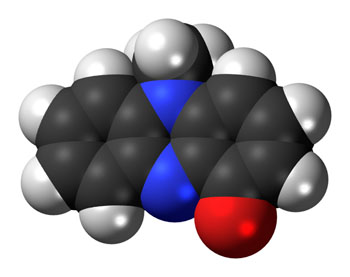An Inexpensive, Disposable Electrochemical Sensor for Detection of Bacteria in Chronic Wounds
By LabMedica International staff writers
Posted on 23 Feb 2016
A recent paper described an inexpensive, disposable electrochemical sensor for the detection of bacteria in chronic wounds.Posted on 23 Feb 2016
Investigators at George Washington University (Washington DC, USA) developed the sensor under the auspices of the WE-HEAL Study, which focuses on the interplay of the host immune response and the wound bed microbiome in patients with chronic wounds.

Image: Space-filling model of the pyocyanin molecule produced by Pseudomonas aeruginosa (Photo courtesy of Wikimedia Commons).
The investigators pointed out that in the field of wound care there was a compelling need to develop rapid alternatives for bacterial identification in the clinical setting, where it generally takes over 24 hours to receive a positive identification. Even new molecular and biochemical identification methods require an initial incubation period of several hours to obtain a sufficient number of cells prior to performing the analysis.
In the current study, the investigators the used an inexpensive, disposable electrochemical sensor to detect pyocyanin, a unique, redox-active quorum sensing molecule released by Pseudomonas aeruginosa, in wound fluid from patients with chronic wounds. By measuring the metabolite excreted by the cells, this electrochemical detection strategy eliminated sample preparation, required less than a minute to complete, and needed only 7.5 microliters of sample to complete the analysis.
The results obtained by the electrochemical technique were compared against 16S rRNA profiling using the 454 pyrosequencing method. Blind identification yielded nine correct matches, two false negatives, and three false positives, giving a sensitivity of 71% and specificity of 57% for detection of Pseudomonas.
"Being able to detect Pseudomonas and other infectious organisms at the time of the clinic visit will greatly enhance our ability to take care of patients," said senior author Dr. Victoria Shanmugam, director of the division of rheumatology at George Washington University. "We would not have to wait for culture results before making a decision about antibiotics, and this would allow us to better tailor therapies for our patients. Infections are a major challenge in medicine, and by using this probe, we were able to harness one of the unique molecules produced by bacteria to detect infection. We plan to continue to refine this testing method and hope to scale it up for detection of other bacteria and to optimize it for clinical use."
The method was described in the January 27, 2016, online edition of the journal Wound Repair and Regeneration.
Related Links:
George Washington University













